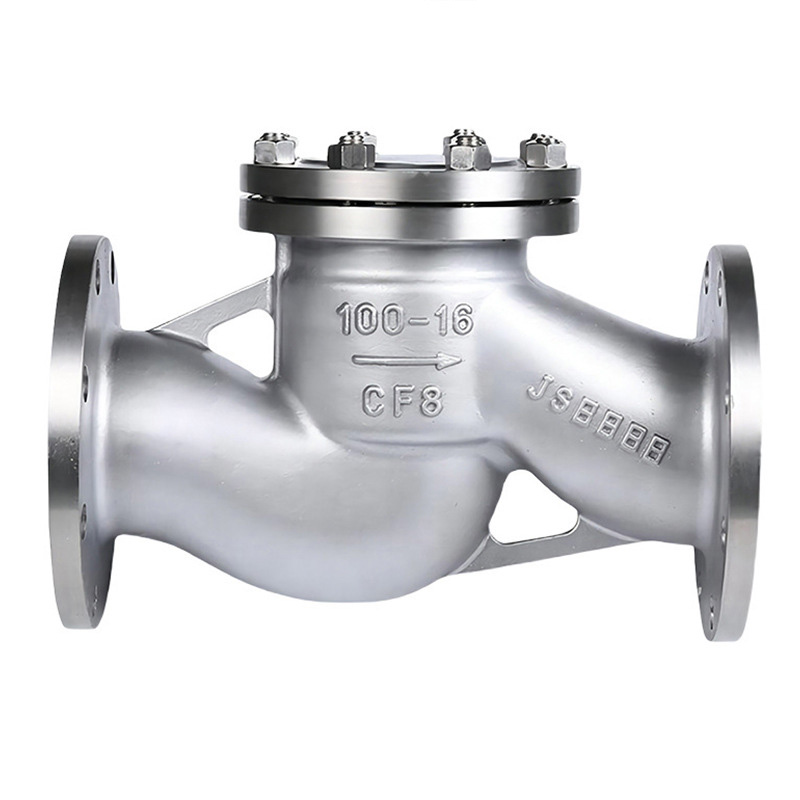يشكل تسرب الصمام، وخاصة في صمامات الفحص، خطرًا كبيرًا. تلعب صمامات الفحص دورًا حاسمًا في منع التدفق العكسي، مما يضمن تدفق السوائل في اتجاه واحد فقط.
تستخدم على نطاق واسع في أنظمة المياه المنزلية، وأنظمة الصرف الصحي، والصناعات البحرية، والنفط والغاز، وأنظمة التدفئة، وتعتبر صمامات الفحص حلولًا فعالة من حيث التكلفة.
ومع ذلك، إذا تعطلت هذه الصمامات، ينشأ خطر التدفق العكسي، مما قد يؤدي إلى عواقب وخيمة، خاصة في الأنظمة الحساسة مثل معالجة مياه الصرف الصحي.
تعد معالجة تسرب صمام الفحص أمرًا بالغ الأهمية لسلامة وموثوقية العمليات الصناعية.
تحدد معايير ANSI 6 مستويات متميزة لمعدلات تسرب صمام الفحص، يشير كل منها إلى نطاق مقبول من التسرب للصمام.
يتم تصنيع صمامات عدم الرجوع المتنوعة بمعدلات تسرب مصممة خصيصًا لمتطلبات محددة.
دعنا نستكشف تفاصيل مستويات معدل التسرب هذه:
التسرب المسموح به هو 0.5% من السعة المقدرة. يتم تقييم السعة عن طريق الضغط على مدخل الصمام مع فتح المخرج.
التسرب المسموح به هو 0.1% من السعة المقدرة. يتم تقييم السعة عن طريق الضغط على مدخل الصمام مع فتح المخرج.
التسرب المسموح به هو 0.01% من السعة المقدرة. يتم تقييم السعة عن طريق الضغط على مدخل الصمام مع فتح المخرج.
التسرب المسموح به هو 0.005 مل في الدقيقة من الماء لكل بوصة.
يتم تقييم السعة عن طريق الضغط على مدخل الصمام بعد ملء جسم الصمام، وتوصيل الأنبوب بالماء، وإبقاء سدادة الصمام مغلقة.
يمكن أن ينجم تسرب صمام عدم الرجوع عن عوامل مختلفة، بما في ذلك التركيب غير الصحيح أو الصيانة غير الكافية أو عيوب تصنيع الصمام.
تعد الدقة والتعامل الدقيق أمرًا بالغ الأهمية في عملية إصلاح صمام عدم الرجوع، والتي غالبًا ما يتم إجراؤها بواسطة متخصصين.
تتناول هذه النظرة العامة المشكلات الشائعة المتعلقة بتسرب صمام الفحص، وتستكشف أسبابها المحتملة، وتوفر حلولاً لحل فعال.
يؤدي فشل الإغلاق في صمامات الفحص، الذي يحدث أثناء التدفق الصفري، إلى تسرب محتمل، مما يشكل مخاطر في بيئات مختلفة.
قد يؤدي ضبط المشكلات في صمامات الإغلاق إلى الإضرار بالوظائف والسماح بالتدفق العكسي الخطير.
تساهم المكونات الداخلية القديمة، مثل الحشيات والغسالات التي تفقد قبضتها، أو انسداد الحطام داخل الصمام، في فشل الإغلاق.
قم بفحص صمام الفحص الصناعي، واستبدل الغسالات التالفة، وقم بتنظيف الصمام جيدًا لمنع حدوث مشكلات في المستقبل.
يؤدي الإغلاق غير الكامل لصمام الفحص إلى حدوث تسرب، وهي مشكلة حرجة تتطلب الاهتمام.
قد تشير التسريبات المستمرة إلى الحاجة إلى استبدال صمام الفحص، خاصة عند التعامل مع المواد الكيميائية الخطرة.
انسداد الحطام: تؤدي الجزيئات الأجنبية التي تعيق إغلاق الصمام إلى حدوث تسرب.
الغسالة المهترئة: الغسالة المتدهورة تعيق الأداء السليم لصمام الفحص، مما يؤدي إلى حدوث تسربات.
التثبيت غير الصحيح: يؤدي حجم صمام الفحص غير المتوافق في حالات معينة إلى حدوث تسرب.
التنظيف الشامل: إزالة الملوثات المسببة للانسداد والتأكد من الأداء السليم للصمام.
استبدال الغسالة: يجب استبدال الغسالات البالية على الفور للحفاظ على قبضة آمنة.
التثبيت الصحيح: تأكد من الحجم الصحيح أثناء التثبيت لمنع مشاكل التسرب. اختر استبدال صمام الفحص في حالة استمرار عدم تطابق الحجم.
يحافظ مقعد الصمام على إحكام إغلاق جسم صمام الفحص، وهو أمر ضروري لمنع تسرب الهواء.
يؤدي الغلق غير الكامل لمقعد صمام الفحص إلى تسرب الهواء والسوائل، مما يتسبب في حدوث مشكلات في النظام مثل الأداء غير السليم والتدفق العكسي. غالبًا ما يتم إجراء الكشف من خلال اختبار الفقاعة.
التثبيت غير الصحيح: يمكن أن يؤدي وضع الصمام والمقعد بشكل غير صحيح إلى تسرب الهواء والسوائل.
البلى: يمكن أن يؤدي تدهور الختم بسبب البلى إلى تسرب مقعد صمام الفحص.
الإصلاح أو الاستبدال: قم بمعالجة ختم المقعد المتسرب عن طريق إصلاحه أو استبداله.
التثبيت الصحيح: تأكد من وضع الصمام والمقعد بدقة أثناء التثبيت.
الصيانة الوقائية: يقلل التشحيم المناسب من تآكل مقعد الصمام، مما يضمن التشغيل لفترة طويلة.
في حين أن العديد من صمامات الفحص تفتقر إلى السيقان، فإن أنواعًا معينة تتميز بسيقان للتحكم الخارجي.
يشير التسرب المرتبط بالجذع في صمامات الفحص، وخاصة صمامات التوقف، إلى وجود خلل وتدفق غير منظم بسبب تلف الجذع أو تركيبه بشكل غير صحيح.
التآكل: يؤدي التآكل المفرط للساق إلى إضعاف قدرته على التحكم في قرص الصمام.
التثبيت غير الصحيح: يؤدي وضع الجذع غير الصحيح إلى تعطيل التحكم في القرص، مما يؤدي إلى تدفق غير منظم.
استبدال الجذع: معالجة التسرب عن طريق استبدال الجذع التالف بالبديل المناسب.
روتين الصيانة: منع مشاكل صمام الفحص من خلال الصيانة والاختبار المنتظمين.
إصلاح التعبئة: يساهم إصلاح تعبئة الصمام في الأداء الفعال للساق.
يعد اكتشاف ومعالجة التسرب في صمامات الفحص، مثل صمام الفحص السيئ أو عند حدوث تسرب للتدفق العكسي من الأعلى، أمرًا بالغ الأهمية.
بمرور الوقت، قد تتلف صمامات الفحص بسبب التآكل، مما يؤدي إلى مشكلات محتملة في التدفق العكسي.
تساعد الصيانة الدورية والاستبدال الفوري للأجزاء البالية على ضمان الأداء الأمثل للصمام ومنع التسرب.
